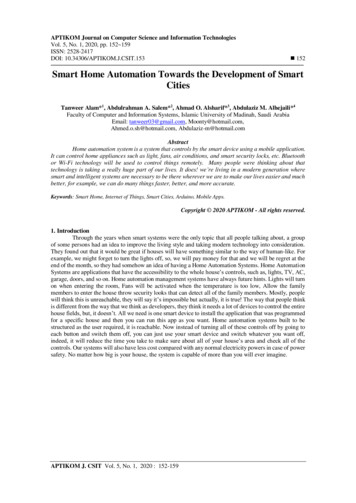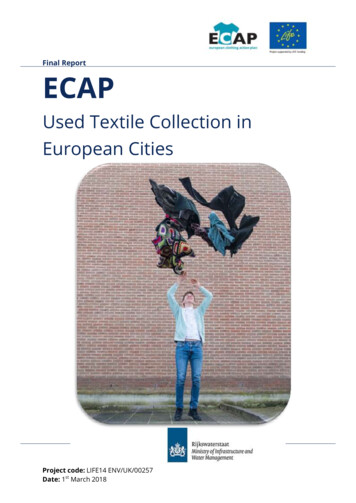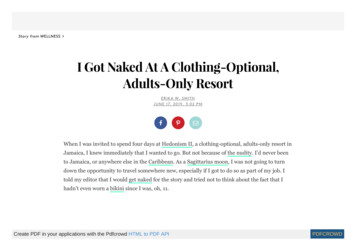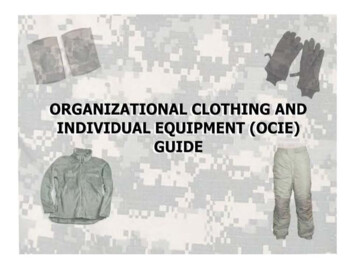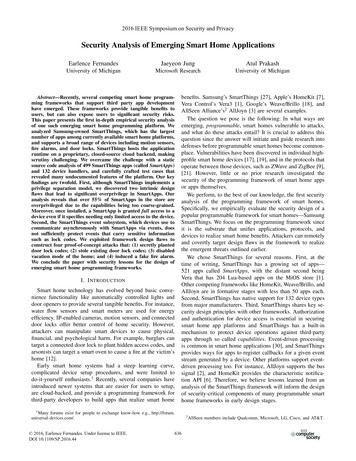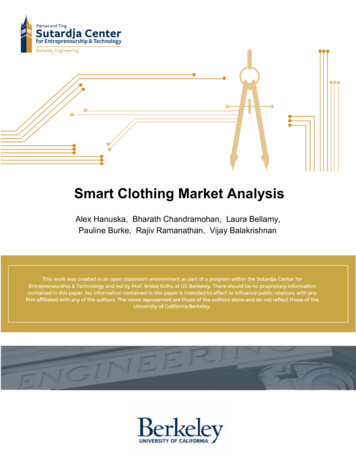
Transcription
Smart Clothing Market AnalysisAlex Hanuska, Bharath Chandramohan, Laura Bellamy,Pauline Burke, Rajiv Ramanathan, Vijay Balakrishnan
Table of ContentsIntroductionExisting Wearables and Smart Clothing LandscapeHistory of WearablesWearable Technology Market SizeSmart Clothing Market SizeVendor LandscapeSmart Clothing Ecosystem Value ChainSmart Clothing Use CasesUse Case: AthleticsCurrent Athletic Smart Clothing Product OfferingsAthletics and Big DataAthletics Market SizeUse Case: HealthcareCurrent Healthcare Smart Clothing Product OfferingsHealthcare Profession and Big DataMarket SizeMilitaryCurrent Military Smart Clothing Product OfferingsMilitary and Big DataMarket sizeSensors & DataBarriers to AdoptionTechnical ChallengesStandards: the language of big dataPrivacy: Securing dataAnalysis: Mining data for valuable contentConnectivity and PortabilityCulturalSpecial Barrier Consideration Pertaining to the MilitaryPath to Market SuccessConclusionReferences
Abstract: The market for wearable technology has been slowly growing since the 1970sand has recently exploded with the popularity of fitness trackers and smartwatches.Although the wearables market is now a 28 billion per year industry1, smart clothingrepresents only a fraction of that market. Unlike personal wearable devices who offerdata insights to the device owner, the power of smart clothing can be best realized whencompanies engage both device owners for personal data insights and perform big dataanalysis for commercial application.IntroductionMuch like the evolution of smartphones and tablets, wearable technology has been wellreceived by early adopters and is now poised to grow into a leader of the consumerelectronics market. Wearables are devices worn on the body for extended periods oftime that have advanced circuitry and independent processing capability.Wearables are evolving as part of a growing trend to move data analysis andcommunication from the smartphone directly to the body. Technologists are using acombination of sensors, machine learning, and big data analysis to provide consumersmore data about their bodies and lives than ever before. This emerging field of productswill have a dramatic impact on human computer interaction.The wearables market has several categories of personal devices, all of which are wornor attached to the body. The categories include smart watches, fitness trackers, smartglasses, body sensors, wearable cameras, location trackers, gesture devices, and smartclothing. These devices serve a wide range of purposes from healthcare to lifelogging, tosafety notifications. Smart clothing, or e textiles, have conductive fibers or sensorsattached to or woven into the clothing material. Like other wearables, smart clothingsends data to a secondary device where the user can evaluate the information.Despite the rapid growth of wearable technology in fitness tracker and smartwatchcategories, other categories are lacking dramatic growth. In particular, smart clothingrepresents less than 1% of the global wearables market.2 The lack of expansion andadoption in this category is due to many factors: Technical challenges with sensor size, sensor accuracy, and device power Cultural challenges in data privacy, device cost, and style1"Gartner Says Worldwide Wearable Devices Sales to Grow ." 2016. 17 Apr. 2016 http://www.gartner.com/newsroom/id/3198018 2"Gartner Says Worldwide Wearable Devices Sales to Grow ." 2016. 17 Apr. 2016 http://www.gartner.com/newsroom/id/3198018
One of the largest challenges to smart clothing adoption is the lack of compelling usecases for personal electronic consumers and the market value of developing and sellingdevices to end users. To realize the potential of smart clothing, companies must developproducts and services that provide both personal data insights to end users as well asproviding big data analytics that provides and delivers commercial value to companiesbuilding it.This research explores the development of wearable technology, the current market sizeof wearable technology and smart clothing, and barriers to smart clothing adoption. Tobest illustrate the value that big data analytics can offer commercial applications, thisresearch explores smart clothing use cases in three market segments: professionalathletics, military industry, and healthcare.Wearables and Smart Clothing LandscapeAlthough the wearable industry gained momentum in the 2000s, a handful of 20thcentury technologies are the originators of wearable technology. From the emergence ofwearables in the 1970s to the current 27B industry, wearables have evolved to a globalmarket serving many industries.3History of WearablesIf you apply the following two part criteria for defining a wearable device, you can seethat the wearable marketplace dates back to the 1970s. Wearables must be: Comfortably worn on the body for extended periods of time Independently powered and use sensors or microcomputers to processinformationIn addition to the notable reduction of size of the wearables device over time, from theSony Walkman’s 0.5 lb to the 0.3 ounce Fitbit Zip, the “smart” component of wearableshas dramatically increased.43"Gartner Says Worldwide Wearable Devices Sales to Grow ." 2016. 17 Apr. 2016 http://www.gartner.com/newsroom/id/3198018 4"Fitbit Zip Wireless Activity Tracker." 2012. 18 Apr. 2016 https://www.fitbit.com/zip
In the last 10 years, “smart” wearables have advanced in two primary areas: the ability to collect personal data (Nike iPod, GoPro) The ability to provide real time data insights to users (Fitbit, Jawbone, Pebble)These advancements, coupled with the ubiquity of smartphones, have primed the marketfor smart, wearable, personal devices such as the Apple Watch. However, notablemissing from the current timeline are smart clothing products. Until recently, technology,cultural, and market conditions have not been aligned to support the adoption of smartclothing.Wearable Technology Market SizeAs evidenced by the top five manufacturers of wearable devices in 2015, the currentmarket is dominated by fitness trackers and smartwatches.55"Worldwide Wearables Market Soars in the Third . IDC." 2015. 18 Apr. 2016https://www.idc.com/getdoc.jsp?containerId prUS40674715
Remarkable in the 2015 sales is the rapid growth and adoption: The #1 app on the iTunes app store on Christmas Day 2015 was Fitbit, indicatinghow popular the gift was. Xioami, which sold no fitness trackers in 4Q14, sold 2.7 million devices in 4Q15. Despite lower than predicted unit sales, the Apple Watch generated 5.5 billion inrevenue. 6The wearables market had higher than expected growth in 2015, where unit sales havedoubled since 2014. As early as 2014, the wearables market was expected to havesteady growth trajectory from 17 million device shipments in 2013 to 187.12 million unitsin 2020 (CAGR of 34%).7 With the recent success of fitness trackers and the emergenceof the Apple Watch to drive smartwatch sales, market analysts have adjusted wearabledevice sales to project even greater device shipments and revenue.86"Wearable Device Market Forecasts: Smart Watches, Fitness ." 2015. 18 Apr. 2016http://www.prnewswire.com/news releases/wearable device market forecasts smart watches fitness trackers smart glasses smart clothing body sensors wearable cameras and other wearable devices for consumer enterprise healthcare industrial public safety sports 300198196.html7"Wearable Device Market Forecasts: Smart Watches, Fitness ." 2015. 18 Apr. 2016http://www.prnewswire.com/news releases/wearable device market forecasts smart watches fitness trackers smart glasses smart clothing body sensors wearable cameras and other wearable devices for consumer enterprise healthcare industrial public safety sports 300198196.html8"Wearable Device Forecast Research Report Tractica." 2016. 18 Apr. 2016https://www.tractica.com/wp content/uploads/2016/03/MD WDMF 1Q16 Executive Summary.pdf
Smart Clothing Market SizeThe 2015 global smartphone market is an impressive 399 billion, but pales incomparison to the clothing market with 1.2 trillion in garment sales. For 2019, this gapis predicted to widen to 520 billion smartphone sales and a whopping 2.2 trillion ingarment sales.9“Clothes will always outsell phones.” Dr. Michael Burrows, DupontGiven the pervasiveness and continual growth of the clothing market, you would assumethat merger of wearable technology with clothing would be an obvious area for marketexpansion. However, growth in this area is predicted to be slow with smart clothingaccount for less than 1% of the market.109"The Economic Impact of the Fashion Industry." 2015. 18 Apr. 0the%20Fashion%20Industry%20 %20JEC%20report%20FINAL.pdf10"Cumulative Wearable Device Shipments to Surpass 750 ." 2015. 18 Apr. 2016https://www.tractica.com/newsroom/press releases/cumulative wearable device shipments to surpass 750 million units by 2020/
The slow adoption might be due to a lack of obvious use cases for consumers startingwith a basic lack of public awareness. Although recent Google searches show “Smartclothing” increasing in popularity, users still are not largely aware of the market offerings.11According to a recent survey of 2,407 consumers in developed and emerging markets, ofwearable technologies, people are least of smart clothing and e textile products.1211"Google Trends Trending Searches." 2011. 18 Apr. 2016https://www.google.com/trends/hottrends12"The relationship between consumers, wearable technology ." 2015. 18 Apr. 2016http://www.lightspeedgmi.mx/resource center/newsletter/relationship consumers wearable technology fashion brands/
Vendor LandscapeConsidering that wearable technology is a relatively new industry, the landscape ispopulated with vendors across many market. Companies in the wearables market havegravitated to four primary marketplaces: Infotainment real time data transmission for entertainment Fitness and wellness monitoring of activity and emotions Military and Industrial real time data transmission in military or industrialenvironments Healthcare and Medical monitoring of vital signs and sense augmentation13Within the landscape, several mature companies have incorporated wearables into theirexisting products to improve the value of their offerings. For example, Adidas nowincludes sensors in many of their athletic shoes and smart bands in many of their fitnessclothing items. These devices have focused on the existing audience of personalconsumer. Other companies have emerged with product offerings solely in the wearable13"Wearable Technology – Market Assessment." 2015. 17 Apr. 2016 http://cdn2.hubspot.net/hub/396065/file 2568104498 pdf/Blog Resources/IHS Wearable Technology.pdf?t 1427903372862
market. For example, Fitbit offers 9 products that all perform fitness tracking and gatherbiometric data for personal consumers.14Established electronics companies (Samsung, Sony, Medtronic, Motorola) will need tocompete with wearables focused companies (Jawbone, GoPro, Pebble) to introduceattractive, affordable, and compelling products to establish dominance in this competitivelandscape.Amongst the current 423 wearable device products on the market, a majority are relatedto fitness and lifestyle.15The following table shows the products that are offered in the four leading marketcategories.CategoryProduct OfferingsInfotainment smart glassesvirtual reality gogglesheads up displays smart watchesBluetooth headsetsFitness and Wellness sleep sensorssmart glassessmartwatchesemotional monitors smart clothingactivity monitorsfitness and heart ratemonitorspedometers smart clothing heads up displaysMilitary and Industrial"Fitbit Official Site for Activity Trackers & More." 2009. 17 Apr. 2016 https://www.fitbit.com/ "Wearable Technology Database Vandrico Inc." 2015. 18 Apr. 2016http://vandrico.com/wearables/1415
Healthcare and Medical hand worn terminals smart glasses smart clothingbiometric monitorschemical monitorsdrug delivery products smart glasseshearing aidssmart watchesdefibrillatorsSmart clothing products are included in three of the four wearables categories, but havelimited product offerings.Smart Clothing Ecosystem Value ChainWe will look at the high level model of how a business providing the analytics andanalytics platform for the smart clothing industry combined raw materials and standardsas input, adds value through various processes and is able to price and sell its productsto customers.Value chain is a term coined by Harvard Business School professor Michael EugenePorter to denote the interrelated, and often sequential, operating activities businessesperform during the process of converting raw materials into finished products sold tocustomers. As products make their way through a company’s value chain, each linkprovides another opportunity to add value that can increase profits16 .16h ttp://www.investopedia.com/video/play/value chain/
The Inputs Sensors (eg., DataGloveTM, Heddoko, Hexoskin, OMSignal, Athos,. ) E Textiles (eg., Fibretronic, ELITEX , Feratec , Tyvek , ) Data Collection systems and methodologies ( eg., Bluetooth, RFID, AWS,. ) Standards for data sharing and security ( e.g., HIMISS , NCHHSTP) The personal records of thousands of individualsThe Value provided by big data analytics To the individual: personalized situational and predictive analysis to improvefunction, protect from injury and increase longevity in profession To the business: trend, analysis, pattern recognition and simulation to decreasecosts and increase productivity IoT data platforms and analytic tools ( e.g. C3 IoT, Meshify, AWS, Oracle, . )The Outputs Training schedules and summaries Alerts to fatigue, injury, exposure Workload maximization Risk reduction Cost/Benefit AnalysisTh
Abstract: The market for wearable technology has been slowly growing since the 1970s and has recently exploded with the popularity of fitness trackers and smartwatches. Although the wearables market is now a 28 billion per year industry1, smart clothing represents only a fraction of that market. Unlike personal wearable devices who offer
